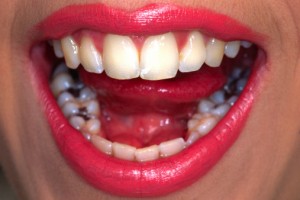Comparing Composite Fillings and Metal Fillings
Information to help guide your choice of material for your fillings.

Metal Fillings
Composition: Sometimes called silver amalgam fillings, metal fillings are made from a mixture of about 50 percent mercury combined with other metals that may include silver, tin, copper, or zinc.
Appearance: Metal fillings are quite noticeable because of their silver color and reflective appearance. However, they may be used on back teeth without affecting the look of your smile.
Uses: Metal fillings can be used to fill larger cavities than white composite fillings, but the dentist must remove extra tooth structure into order to ensure a good bond with the metal filling. Metal fillings are considered very durable and are often used for fillings on the biting surfaces of molars.
Health & Safety: Although metal fillings do emit a small amount of mercury vapor, this amount is lower than what you would encounter in the natural environment and exposure to intact metal fillings is judged safe by the EPA. However, metal fillings may cause issues for individuals with metal allergies.
Cost: Metal fillings are the least expensive option for treating a cavity.
Lifespan: Because metal fillings are quite strong, and because of the way the liquid mercury bonds with the tooth, metal fillings have an excellent track record of lasting for decades if properly cared for.
Composite Fillings
Composition: Composite fillings are made from glass or silica, resin, and a light-activated chemical that helps that material set quickly once placed in the tooth.
Appearance: Composite fillings are the most aesthetically pleasing type of filling to get, because they can be tinted to match the color of your natural tooth enamel. When placed by a talented dentist in Upland CA they are virtually invisible.
Uses: Composite fillings can be used to fill most types of cavities, though they may not be recommended for particularly large cavities. Because the composite material can stick to a flat surface, this type of filling can also be used to build up broken teeth.
Health & Safety: Composite fillings are metal-free, which is excellent news to those with metal allergies or concerns about dental mercury.
Cost: Composite fillings are more difficult and time-consuming for a dentist to place and tend to cost more than metal fillings.
Lifespan: New and improved types of composite fillings are constantly being developed, and over the years these improvements have made the material more durable and longer-lasting even on molars. However, one potential concern is that because composite fillings shrink ever so slightly as they cure, they leave microscopic gaps around the edge of the filling. This can provide a pathway for cold, heat, and bacteria to enter the tooth. This increases the risk of sensitivity as well as the likelihood of premature failure of the filling.




